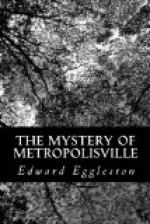CHAPTER XXVI.
THE MYSTERY.
I have before me, as one of the original sources of information for this history, a file of The Wheat County Weakly Windmill for 1856. It is not a large sheet, but certainly it is a very curious one. In its day this Windmill ground many grists, though its editorial columns were chiefly occupied with impartial gushing and expansive articles on the charms of scenery, fertility of soil, superiority of railroad prospects, admirableness of location, healthfulness, and general future rosiness of the various paper towns that paid tribute to its advertising columns. And the advertising columns! They abounded in business announcements of men who had “Money to Loan on Good Real Estate” at three, four, five, and six per cent a month, and of persons who called themselves “Attorneys-at-Law and Real Estate Agents,” who stated that “All business relating to pre-emption and contested claims would be promptly attended to” at their offices in Perritaut. Even now, through the thin disguise of honest-seeming phrases, one can see the bait of the land-shark who speculated in imaginary titles to claims, or sold corner-lots in bubble-towns. And, as for the towns, it appears from these advertisements that there was one on almost every square mile, and that every one of them was on the line of an inevitable railroad, had a first-class hotel, a water-power, an academy, and an indefinite number of etcaeteras of the most delightful and remunerative kind. Each one of these villages was in the heart of the greatest grain-growing section of the State. Each, was the “natural outlet” to a large agricultural region. Each commanded the finest view. Each point was the healthiest in the county, and each village was “unrivaled.” (When one looks at these town-site advertisements, one is tempted to think that member serious and wise who, about this time, offered a joint resolution in the Territorial Legislature, which read: “Resolved by the Senate and House of Representatives, That not more than two thirds of the area of this Territory should be laid out in town-sites and territorial roads, the remaining one third to be sacredly reserved for agricultural use.”)
But I prize this old file of papers because it contains a graphic account of the next event in this narrative. And the young man who edited the Windmill at this time has told the story with so much sprightliness and vigor that I can not serve my reader a better turn than by clipping his account and pasting it just here in my manuscript. (I shall also rest myself a little, and do a favor to the patient printer, who will rejoice to get a little “reprint copy” in place of my perplexing manuscript.) For where else shall I find such a dictionariful command of the hights and depths—to say nothing of the lengths and breadths—of the good old English tongue? This young man must indeed have been a marvel of eloquent verbosity at that period of his career. The article in question has the very flavor of the golden age of Indian contracts, corner-lots, six per cent a month, and mortgages with waiver clauses. There, is also visible, I fear, a little of the prejudice which existed at that time in Perritaut against Metropolisville.




